Your browser's Javascript functionality is turned off. Please turn it on so that you can experience the full capabilities of this site.
With Canada’s unpredictable winter weather conditions, drivers have come to appreciate the added traction and safety of All-wheel drive (AWD) vehicles. To get the best performance, do you know when to rotate AWD tires?
There’s a common misconception that tire rotation isn’t necessary for AWD vehicles. Some think that since AWD systems constantly deliver power to all four tires, the tires are all wearing at the same rate.
However regular tire maintenance, including tire rotations, is important for all-wheel drive vehicles—in part because different auto manufacturers have developed several variations of AWD systems.
Part-time: In normal driving conditions, one axle receives power. In slippery conditions, the driver can engage the other axle with the press of a button (or lever).
Full-time: All wheels are powered at all times.
On-demand: Vehicle sensors detect slippery road conditions, and automatically deliver power to the other axle until normal road conditions resume.
No matter which AWD system your vehicle has, each wheel position will experience a different degree of steering, weight dispersion and traction. When tires are allowed to run on every wheel position, they wear out more uniformly, decreasing the chance of irregular wear.
Next to checking tire pressure, proper rotation is the second-most important maintenance item for any vehicle, including AWD’s. That’s because tire rotations:
When your tires are in peak condition, you enjoy smooth, safe driving as well as savings with long-lasting tires.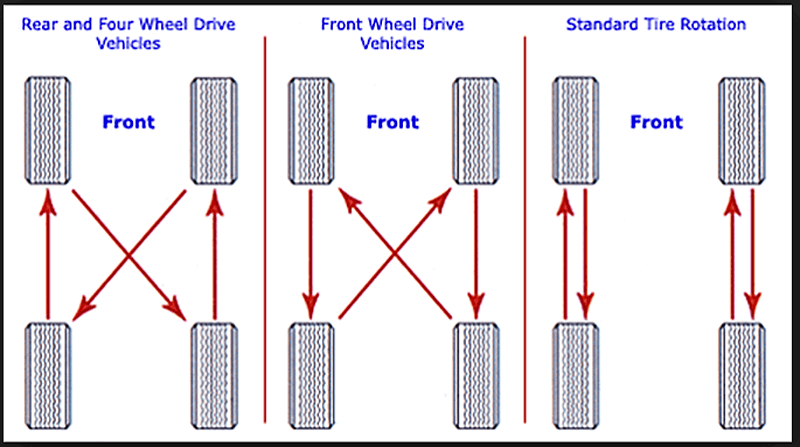
Ensuring that all four tires are as uniform as possible puts less stress on the components of your AWD system. If the difference in diameter between two tires on the same axle is off by even 1/16 of an inch, it’ll mean one tire is spinning at a substantially different rate than its partner. This can cause the AWD system extra stress, and possibly result in failure.
Best practice is to rotate your tires every 8,000-10,000 kilometres, or every other oil change. For rear-wheel drive or AWD/4WD, the rotation pattern goes as follows:
If you have a full-size spare tire, it should be added to your regular rotations. Keeping the spare tire’s tread equal with the others in an AWD or 4WD will prevent damage to the driveline (the mechanism that sends power from the engine to your wheels).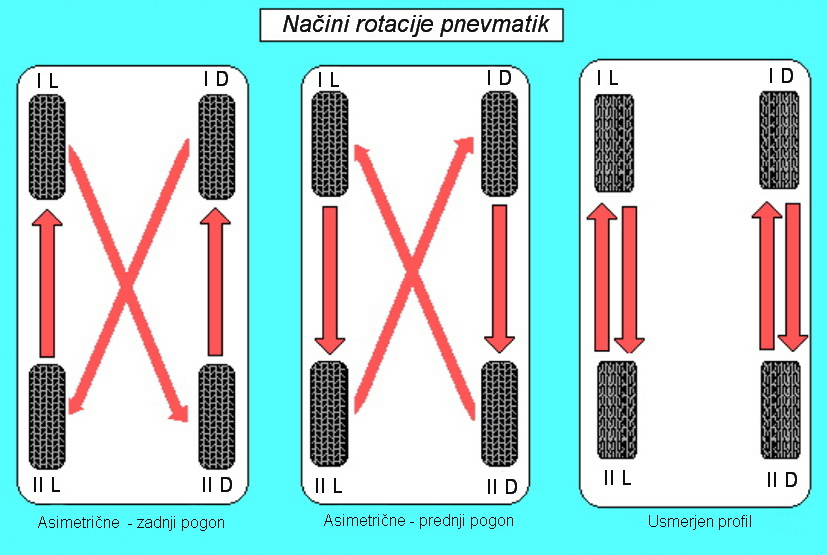
Are you noticing uneven tread wear on your all-wheel drive vehicle’s tires
or think you might be due for a tire rotation?
Find a Location
Was this article helpful?
Click on thumbs up or down to vote.
Frequent winter storms during the 2008-10 winter seasons may have been the reason for the increase in all-wheel drive (AWD) vehicle sales in the U.S. Toward the end of 2010, AWD vehicles accounted for over one-third of new passenger car sales.
Intuitively, one would think that an AWD vehicle would not require regular tire rotations because power is constantly directed to all tires; therefore, all of the tires would wear at the same rate. That is the thought lingering in the minds of some AWD vehicle owners. But when it comes down to it, tire rotation is the second most important maintenance item (tire pressure being first) that can be done to maximize tire life, and this pertains to AWD vehicles, as well.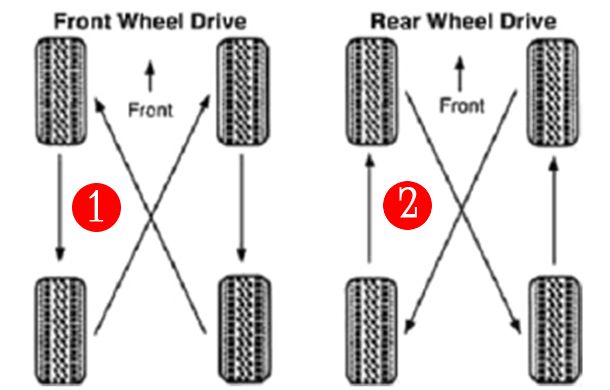
In last month’s Tire Tech column, we talked briefly about tire noise and a tire tread block element. The amount of forces acting on the tread is astounding due to a vehicle’s weight, speed and traction requirements.
As far as tire wear goes, the mechanism that induces tire wear is slip. Think back to high school physics class and the subject of friction. The force required to move an object along a surface equals the coefficient of friction multiplied by the load on the object.
Reaching this level of force, or wheel torque in this case, while driving usually results in wheel spin during acceleration or lock-up of a wheel under braking. Every time slip occurs, rubber molecules are sheared away from the tire tread and left on the roadway surface.
Slip also occurs as a vehicle turns a corner or changes direction. Tire engineers refer to the slip angle of a tire, which is the difference between the direction the tire is pointing and the actual path the tire takes.
As a side note, when the slip angle of the front tires is greater than the rear tires, then an understeer or push condition occurs.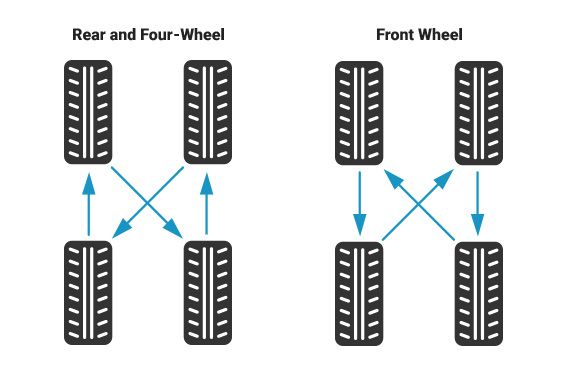 The opposite occurs when the slip angle of the rear tires is greater than the front tires, also known as oversteer. Most production road vehicles are designed to understeer because oversteer requires a bit more driver skill to correct and a majority of drivers do not have that specific skill set. We will come back to slip angle in just a moment.
The opposite occurs when the slip angle of the rear tires is greater than the front tires, also known as oversteer. Most production road vehicles are designed to understeer because oversteer requires a bit more driver skill to correct and a majority of drivers do not have that specific skill set. We will come back to slip angle in just a moment.
Focusing on treadwear, tire engineers manipulate the angles of the groove walls, or sides of the tread blocks, to control the amount of movement that the tread block experiences as it enters, rolls through and exits the footprint.
Think of a tread block as a flexible column. The tread block squirms a given amount due to the tremendous compression load it sees as it goes through the footprint. Designing the sides of the tread block to be perpendicular to the road surface provides maximum groove volume for hydroplaning performance, but it compromises the column strength of the tread block, which eventually leads to more movement in the footprint, and subsequently, a higher treadwear rate.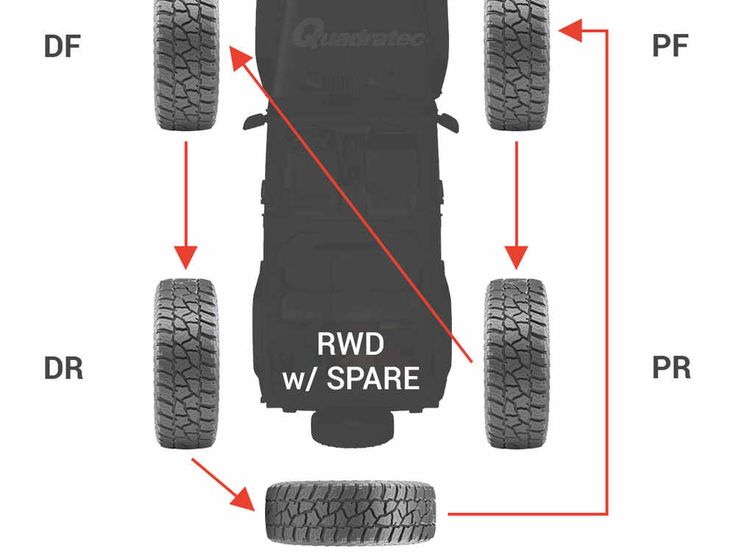
Perfect Balance – and Rotation
We all understand that a tire engineer’s job is a balancing act. Rather than designing the sides of the grooves to be perpendicular to the road surface, tire engineers adjust the angle from three degrees and greater to achieve the proper strength needed to prevent or minimize squirm or slip in the footprint, yet provide adequate groove volume for hydroplaning performance. The key for long tread life is minimizing movement of the tread blocks during straight-ahead rolling.
Next, we add in vehicle alignment to the treadwear recipe. Most automakers design vehicle suspensions with adjustable caster, camber and toe to achieve a desired level of handling and treadwear balance. The vehicle’s alignment specifications add complexity to the stresses on the tire tread, which can result in irregular wear as the vehicle rolls down the highway.
Considering that a vehicle’s weight distribution is generally 60% on the front axle and 40% on the rear axle, the reduced load on the rear tires can sometimes result in higher irregular wear because there is not enough weight to prevent straight-ahead rolling slip.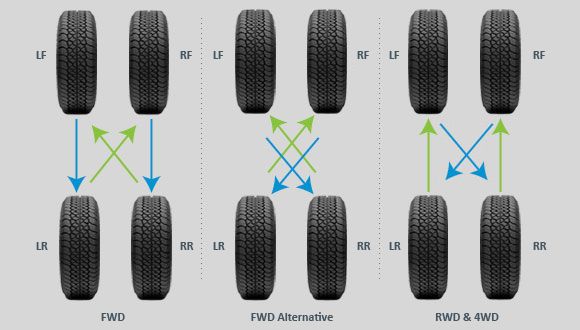 An improper rear alignment will certainly guarantee irregular wear.
An improper rear alignment will certainly guarantee irregular wear.
Regularly scheduled tire rotation is critical for long and even wear. Allowing each tire to run on every wheel position during the life of the tire will mix up the duty cycle for the tread pattern and prevent irregular wear patterns from setting in and reducing overall tread life. Irregular wear patterns also produce unnecessary and elevated tread noise.
Now getting back to slip angle, since most vehicles have some level of understeer designed into them, the front tires will experience more slip than the rear tires. This reason alone is why regular tire rotation is necessary.
For front-wheel drive vehicles, the Forward-X rotation is recommended. For rear-wheel drive vehicles, the Rearward-X or X-rotation is best. This assumes that the front and rear tire sizes are the same.
For different sizes with non-directional tread patterns, rotation from side-to-side is the only option. Asymmetric tread patterns can be considered as non-directional. Front-to-rear rotation is applicable for directional tread patterns with the same size front and rear. Simple tire rotation does not apply to directional tread patterns with different front and rear sizes. The only option is to have the tires dismounted and remounted on the opposite side of the vehicle.
Front-to-rear rotation is applicable for directional tread patterns with the same size front and rear. Simple tire rotation does not apply to directional tread patterns with different front and rear sizes. The only option is to have the tires dismounted and remounted on the opposite side of the vehicle.
A majority of AWD vehicles generally operate in two-wheel drive mode and activate AWD based on demand. Wheel speed sensors detect a loss of traction and torque is directed to the wheel positions with better grip. The few exceptions in the market split power between the front and rear axle constantly and also redirect power to the axle with the most traction; some makers of these AWD systems may wrongly insist that one cannot use simple tire rotation patterns.
Regardless, each wheel position on an AWD platform sees varying degrees of driving traction and steering. Regular intervals of tire rotation between every 5,000 to 7,500 miles will maximize tire life and provide the best available traction and handling balance for the vehicle. If the drivetrain is primarily 2WD, then follow the rotation pattern correct for front- or rear-drive and the tread pattern.
If the drivetrain is primarily 2WD, then follow the rotation pattern correct for front- or rear-drive and the tread pattern.
Tires are the car's only connection to the road. To prolong their service life, change tires in places.
Cars are rear-wheel drive, like the BMW 5 Series and Mercedes C-class, front-wheel drive, like the Toyota Prius and all-wheel drive, these are mainly jeeps like the VW Touareg. If the car is front-wheel drive, the engine torque is transmitted to the front wheels, in rear-wheel drive to the rear wheels, and in full to both the front and rear wheels at the same time. Depending on the drive of the car - front, rear or full, tires will wear out at different rates. The main load falls on the drive wheels - they have more friction force when starting the car and braking, which means they wear out faster. At the same time, the wheels in front also experience additional load from the weight of the engine and gearbox, standing in front of the car. nine0003
nine0003
By swapping tires, their wear is evened out and the service life is extended. It is recommended to change them every 5000 - 8000 kilometers, or at least every time the oil in the car engine changes. If the vehicle is driven only on weekends, change tires at least once every six months.
First remove the wheels and check that they are not worn to holes, bumps or damage. Check if the rims are not deformed from strong impacts when they hit a pothole on the asphalt. Most often, the deformation occurs on the inside of the rim. From driving fast on a bad road, the disc can become egg-shaped - this is not noticeable to the naked eye. Curved rims cannot be balanced, so ask for the wheels to be balanced when replacing them at the tire shop, if the rim is bent, the master will report this and offer to align the rims for an additional fee. nine0003
When examining tires, uneven wear may be observed, i.e. uneven tread wear in different places (see picture). This is more common in older vehicles with suspension systems that wear out and need to be repaired, with frequent aggressive braking and misaligned wheels. The tire does not face straight, so the tread wears unevenly, which affects steering and the vehicle's ability to brake. If the tread is unevenly worn on the inside or outside, the machine probably needs to be aligned. Read how to do it yourself here. It is recommended to check the wheel alignment every 30 thousand kilometers. nine0003
This is more common in older vehicles with suspension systems that wear out and need to be repaired, with frequent aggressive braking and misaligned wheels. The tire does not face straight, so the tread wears unevenly, which affects steering and the vehicle's ability to brake. If the tread is unevenly worn on the inside or outside, the machine probably needs to be aligned. Read how to do it yourself here. It is recommended to check the wheel alignment every 30 thousand kilometers. nine0003
A rippled side wall - a bulge on the side of a tire - can result from falling into a deep hole. The tire is pinched, a rupture occurs inside and air enters the rubber layers, as a result, a bump comes out. Left unattended, a bulge in a wheel can lead to a puncture or sudden deflation, resulting in loss of control and an accident.
There are three ways to swap tires. They are only suitable for cars with wheels of the same size and one season. Tires should not be unidirectional, that is, not those that are placed in a certain direction indicated by the manufacturer on the sidewall, based on the tread pattern. If a unidirectional tire is installed incorrectly and it rotates in the opposite direction, this will lead to its rapid wear and damage to the car's ride. nine0003
If a unidirectional tire is installed incorrectly and it rotates in the opposite direction, this will lead to its rapid wear and damage to the car's ride. nine0003
Replacement scheme for front-wheel drive vehicles: front tires are placed back on the same side, and the rear tires are placed in the opposite front corner, for example, the right rear is placed in place of the left front.
Replacing scheme for rear-wheel drive vehicles: rear tires are placed forward on the same side, and the front tires are placed in the opposite rear corner, for example, the right front is placed in place of the left rear.
4WD replacement scheme: crosswise all four tires - right front to left rear, left front to right rear, left rear to right front and right rear to left front. nine0003
An all-wheel drive vehicle does not mean that tires do not need to be swapped. There is a misconception that on all-wheel drive vehicles, the tread wears out evenly. It is not true. All-wheel drive systems do not always drive all wheels.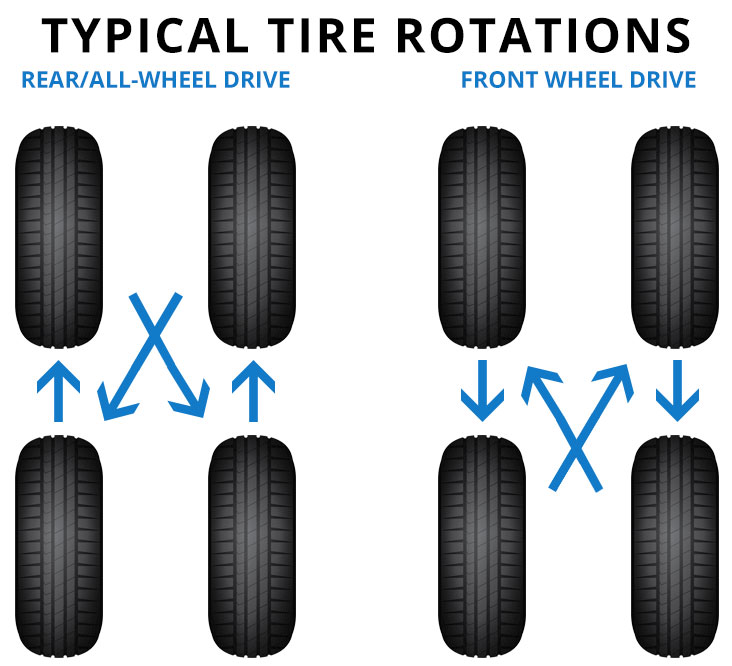 Transfer cases and electronically controlled differentials can switch power between the front and rear wheels, depending on road conditions and the drive mode the driver has selected. The difference in vehicle weight between front and rear also affects tire wear. nine0003
Transfer cases and electronically controlled differentials can switch power between the front and rear wheels, depending on road conditions and the drive mode the driver has selected. The difference in vehicle weight between front and rear also affects tire wear. nine0003
Separately, we dwell on the rule of swapping tires of different sizes (for example, in tuned versions of the BMW 5 Series, the rear tires are placed wider than the front) and unidirectional tires, which should only rotate in a certain direction. If the wheels are of different sizes, then you need to change them from right to left, and left to right. If the wheels are unidirectional, then replacing the cross with a cross is out of the question. Unidirectional tires change right rear with right front, and left rear with left front. nine0003
When replacing tires in places, if you do it yourself, use a torque wrench when tightening the mounting bolts so as not to "tighten the bolt" or, God forbid, "not hold out.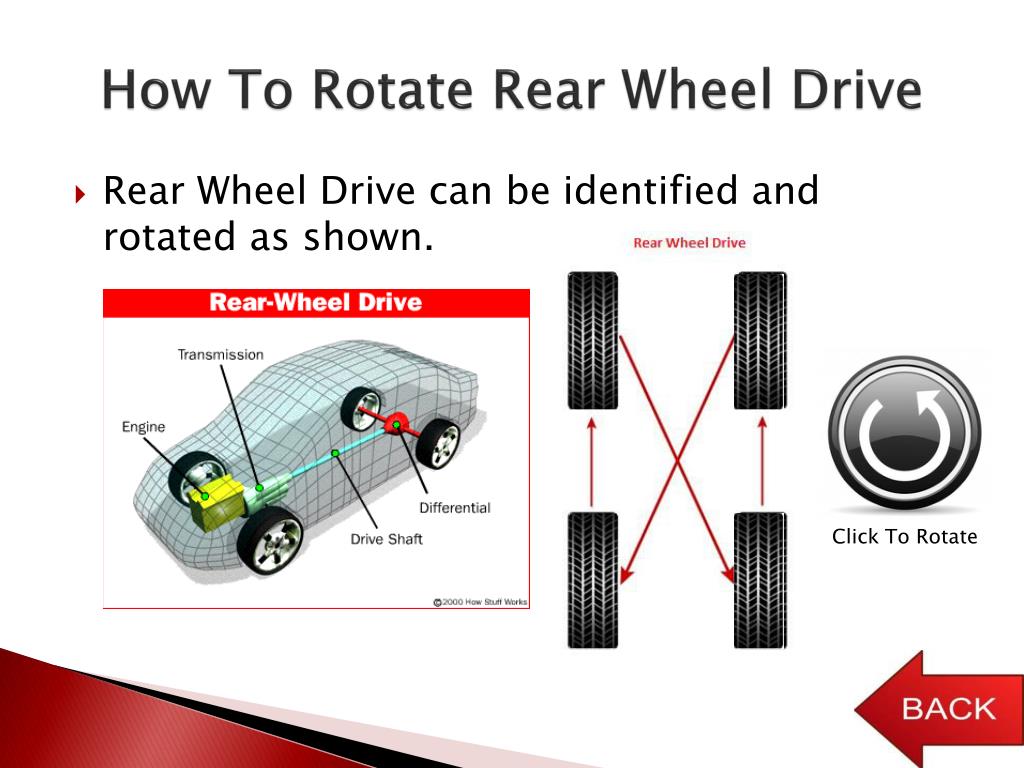 " The approximate tightening range is 80-140 Nm, depending on the car model. Refer to the user manual for the correct tightening torque.
" The approximate tightening range is 80-140 Nm, depending on the car model. Refer to the user manual for the correct tightening torque.
If in doubt about the correct direction of tire rotation, consult your owner's manual, your dealership, or speak to an expert who is familiar with the vehicle. Try to swap your tires at least once a season - this will help your tires last longer and save you money. nine0003
All tires are divided into several types and types. During manufacture, tires are marked with a marking that indicates its main parameters and characteristics. We will not delve into the markings, but we will consider the main differences. Tires are divided into two large groups according to the way the cord is laid inside the tire during its manufacture.
These are radial tires and bias tires. Tires of these two types can be winter, summer and all-weather. Each of these three tires can have a regular or directional tread pattern. nine0049 A tire with a regular pattern can be installed on either side of the car, a tire with a directional pattern is installed strictly in the direction of rotation. Regular and directional tread patterns can be symmetrical or asymmetrical. A tire with such a pattern is placed according to the rule of a tire with a regular or directional pattern.
Each of these three tires can have a regular or directional tread pattern. nine0049 A tire with a regular pattern can be installed on either side of the car, a tire with a directional pattern is installed strictly in the direction of rotation. Regular and directional tread patterns can be symmetrical or asymmetrical. A tire with such a pattern is placed according to the rule of a tire with a regular or directional pattern.
It is possible to buy 4 identical tires and assemble them with rims according to the right and left sides of the car. You will get two left wheels and two right ones. Very rarely come across directional tires with an asymmetrical pattern and with an indication of the inside and outside. These tires need to buy two on each side. Two right and two left, but it is better to refuse such tires altogether. They are not convenient to use. nine0003
Radial tires are preferable for cord construction. Such tires are more reliable, they withstand heavy loads during movement, and are more stable during deformation.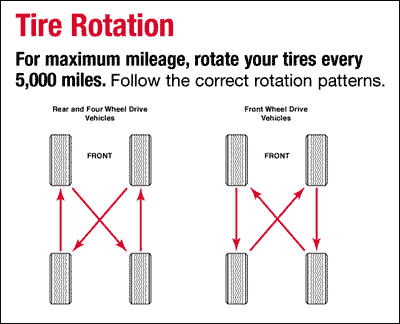 Radial tires wear longer than diagonal tires. Therefore, tires with a diagonal ply are currently practically not produced. Almost all car owners have two sets of tires. For the operation of a car in the winter - these are winter tires, for the summer period - summer.
Radial tires wear longer than diagonal tires. Therefore, tires with a diagonal ply are currently practically not produced. Almost all car owners have two sets of tires. For the operation of a car in the winter - these are winter tires, for the summer period - summer.
All season tires can be used in both summer and winter. Winter tires can be studded. Such tires are allowed only in a few countries, where snow often and abundantly falls in winter, frost forms on the road surface. This list also includes Russia. All-season, summer and winter tires have their own pattern characteristics that increase the car's handling. nine0003
Front or rear wheel drive vehicles can be fitted with different tire patterns. Such tires are installed in pairs on one axle, for example, tires with one pattern are in front, and with another in the back. It is forbidden to install diagonal tires on one axle and radial tires on the other. The dimension must be the same. On all-wheel drive vehicles, the same tires must be installed.
Tires with different treads and dimensions are strictly prohibited. This is due to the design of the transmission. If you operate a car with different tires, then the car's transmission will quickly fail. In addition, driving on different tires becomes dangerous, a car on a slippery road will behave unpredictably. nine0003
All car manufacturers and tire manufacturers recommend changing tires while driving. What is it for? During the operation of the car, all tires wear out unevenly. This is due to several factors. Heterogeneity of the road surface, operating conditions and vehicle transmission device. Therefore, in order to extend the life of the tires and the transmission of the car, the tires must be periodically replaced. nine0003
On all-wheel drive vehicles, uniform tire wear is more relevant. Car manufacturers recommend several tire rotation schemes. But in practice, as is often the case, it is impossible or impractical to apply such tire swap schemes. Many car owners never swap tires. Which of course is wrong.
Many car owners never swap tires. Which of course is wrong.
How do you change tires and how often should you do it? The frequency is approximately 8 - 12 thousand kilometers. Therefore, tire swapping can be timed to coincide with the change of tires from summer to winter and vice versa. nine0047 Winter tires can be studded. When using these tires, the studs tilt to one side. This is due to frequent wheel slip.
Therefore, these tires must be installed in the same direction as they were before. In this case, the tires from the front axle must be put on the rear axle, and the tires from the rear axle should be put on the front axle. In order not to get confused where which wheel was, in a tire shop, the master usually puts a mark on the wheel. If you apply one of the recommended schemes and change the direction of rotation to the opposite when installing the tires, the spikes will begin to tilt in the other direction, their fastening in the tread will weaken and they will start to fly out. nine0003
nine0003
Which, of course, does not justify the expediency of rearranging the tires strictly according to the scheme. There is no point in this, the tires will wear out evenly, but the spikes will almost all fall out. If the tires are not studded, but have a directional pattern, the tires must also be rearranged, from the front axle to the rear, from the rear axle to the front without changing the installation side on the car. If the tires do not have a direction of rotation, then it is possible to apply a more complex scheme.
In this case, the rear tires are moved to the front axle in accordance with the sides. And the front tires are placed on the rear axle, but at the same time the right wheel is placed on the left, and the left wheel is placed on the right. nine0048 There is another scheme for rearranging wheels. In this scheme, a spare wheel is also involved. The spare must of course be identical. When using such a scheme, the tires wear out a little longer during operation. If the vehicle is fitted with all-season tyres, it is best to change the tires in the middle of the season. That is, in summer and winter, and not during periods of changing seasons. And it turns out that some wheels constantly "ride" on the snow in front, and the other pair - on asphalt in the summer on the rear axle. Wear will again be uneven. When using a rearrangement scheme without the participation of a spare tire, the latter does not wear out. There is a situation when you have to put a spare tire on the car and drive it. The difference between the tread height of worn tires and the spare wheel adversely affects the vehicle's transmission.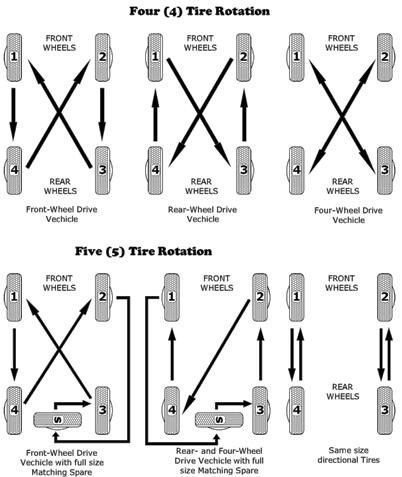 In this case, the rear tires are rearranged to the front axle without changing sides, the spare wheel is placed on the rear axle on the right, and the right front wheel is placed back on the left. The front left wheel becomes a spare. But such a scheme can be applied if non-studded tires and tires with a non-directional pattern are installed on the car. nine0003
In this case, the rear tires are rearranged to the front axle without changing sides, the spare wheel is placed on the rear axle on the right, and the right front wheel is placed back on the left. The front left wheel becomes a spare. But such a scheme can be applied if non-studded tires and tires with a non-directional pattern are installed on the car. nine0003 ![]()